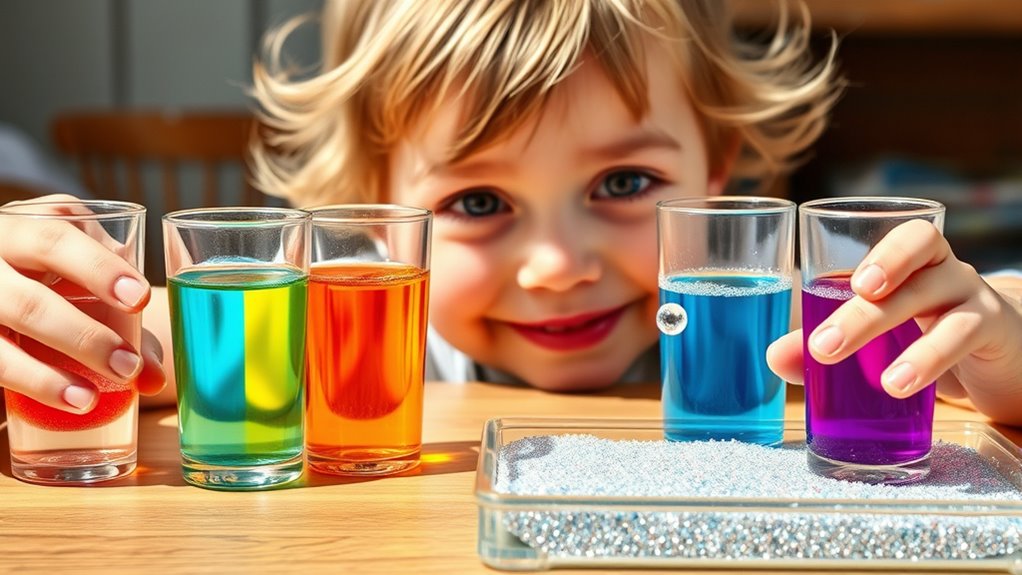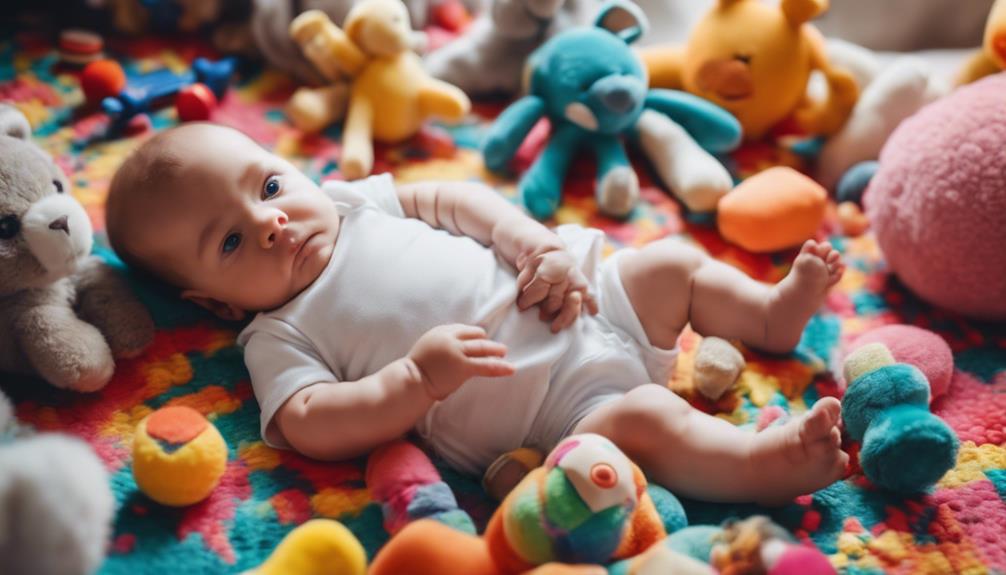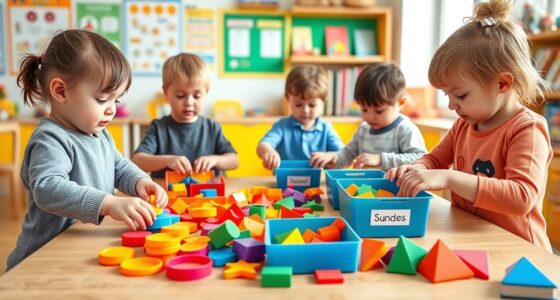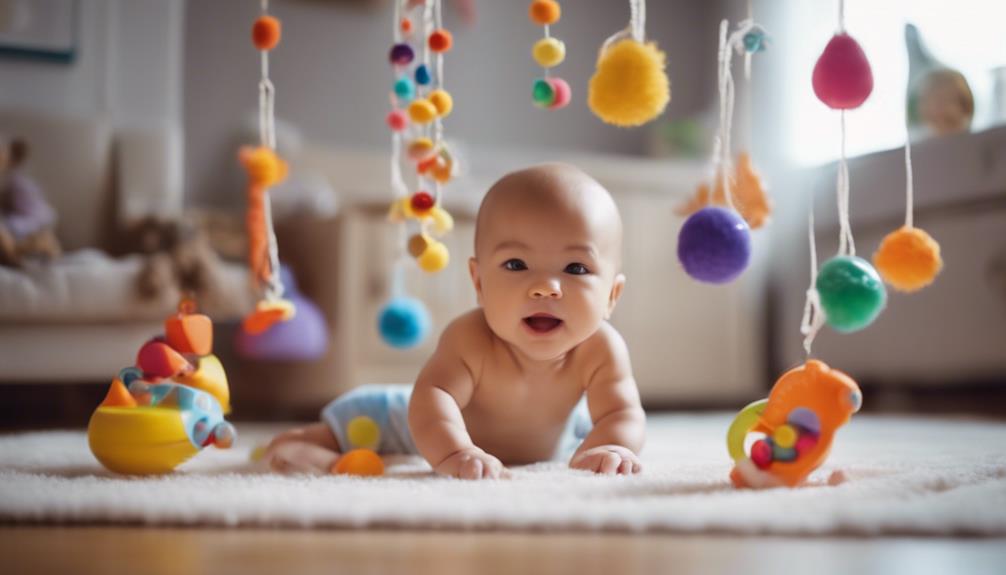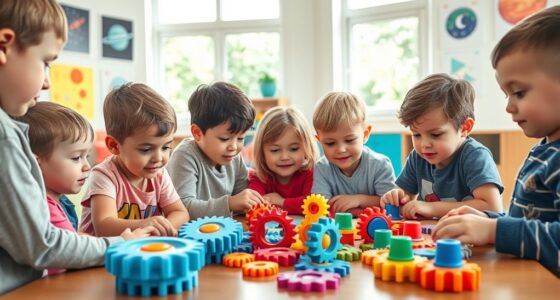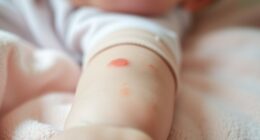You can explore simple science experiments with your curious toddler that are both fun and educational. Try mixing water with food coloring to see how colors blend, or build a baking soda and vinegar volcano to demonstrate a fun chemical reaction. Use balloons to explore static electricity, or observe how sponges absorb water and change color. Creating rainbows with water and light also amazes kids. Keep exploring, and you’ll discover more exciting activities to nurture their curiosity.
Key Takeaways
- Use water and food coloring to explore color mixing and observe how colors blend visually.
- Create a simple baking soda and vinegar volcano to demonstrate basic chemical reactions and cause-and-effect.
- Experiment with static electricity by rubbing balloons and observing attraction or shocks in a playful way.
- Show water absorption and color change by dipping sponges into colored water, highlighting material differences.
- Make a rainbow using a glass, water, and a mirror to teach light refraction and natural optical phenomena.
Exploring Color Mixing With Water and Food Coloring
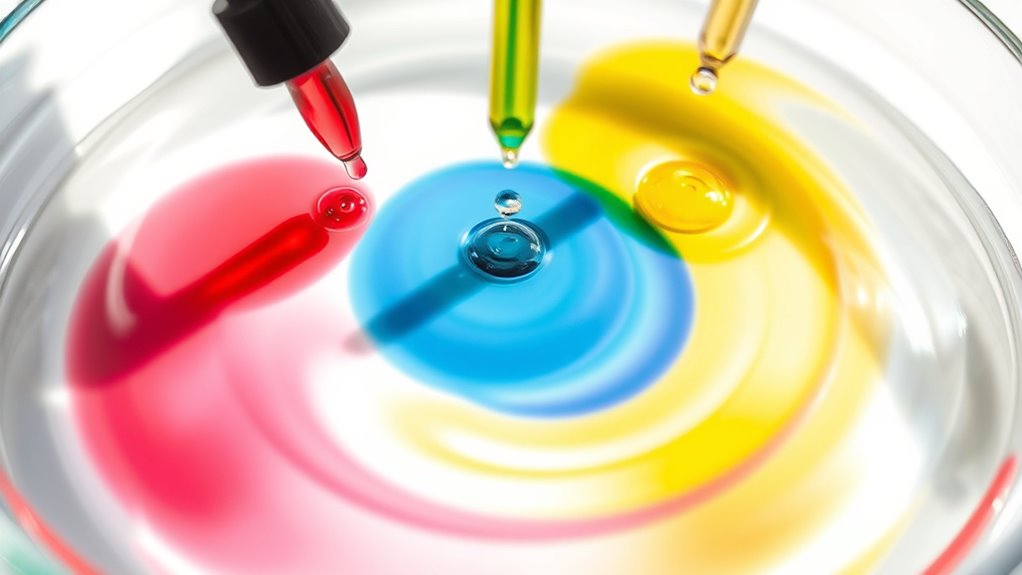
To explore how colors blend, set up a simple water and food coloring experiment. Fill clear glasses or bowls with water and add different food coloring drops to each. Encourage your toddler to observe how the colors initially stay separate. Then, gently mix the colors with a spoon or straw, watching as they blend together. This activity highlights how color blending changes the visual perception of colors, creating new shades and patterns. As your toddler observes, discuss how the colors transform, fostering an understanding of how our eyes perceive mixtures. This hands-on experiment enhances their ability to see how colors interact and merge, laying a foundation for understanding color theory and visual perception in a fun, engaging way. Understanding color perception helps deepen their appreciation of how colors work together and change when combined. Additionally, talking about the light refraction involved in color blending can enrich their curiosity about how light and colors interact visually.
Making a Baking Soda and Vinegar Volcano
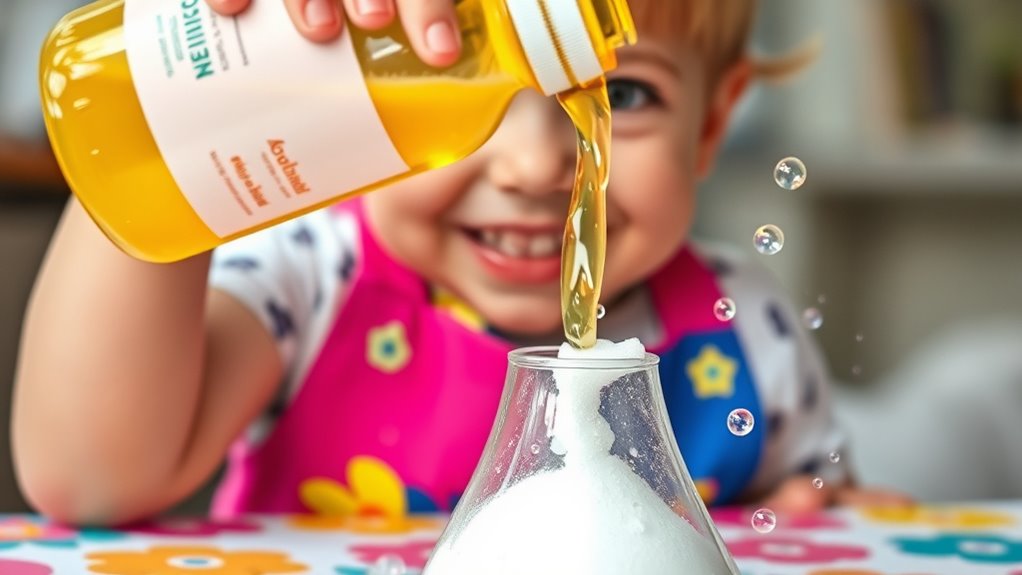
Creating a baking soda and vinegar volcano is a fun way to introduce your toddler to basic chemical reactions. Start by building a simple volcano model using clay or a small container shaped like a mountain. Once your model is ready, add a few spoonfuls of baking soda into the volcano’s crater. When you pour vinegar over the baking soda, a fizzing eruption occurs, mimicking a real volcano’s lava flow. This experiment demonstrates chemical reactions in a visual and engaging way, helping your toddler understand cause and effect. The bubbling and foaming are exciting to watch and make science feel like play. Incorporating visual elements like colorful drawings or pictures can make the experiment even more captivating for young children. Using safe and non-toxic materials ensures the activity remains safe and supervised, allowing your little scientist to learn through hands-on discovery. Additionally, explaining the science behind the reaction can turn the activity into an educational experience that fosters curiosity about basic chemistry concepts. Understanding resources and tools involved in science experiments can further enhance your child’s learning experience and safety during activities.
Discovering the Magic of Static Electricity With Balloons
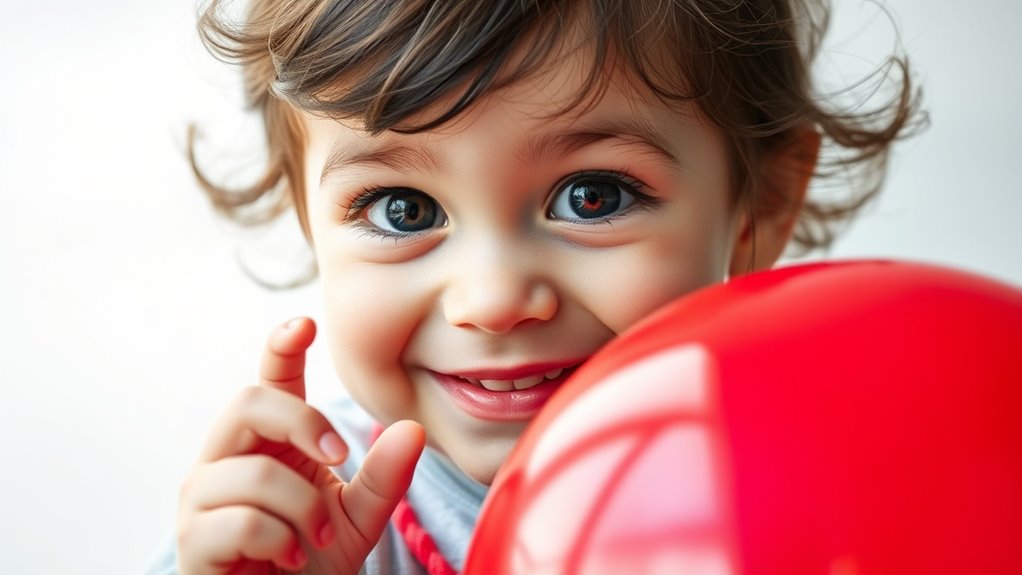
Static electricity might seem like magic, but it’s actually a fascinating science phenomenon you can explore with your toddler using simple materials. When you rub a balloon on your hair or a wool sweater, it transfers electric charge, creating static energy. This buildup can cause a small static shock or make objects like paper or hair stand up. As you bring the balloon close to a wall or your toddler’s hair, they’ll see how static electricity attracts lightweight items. The balloon gains a negative charge, while the objects gain a positive charge, making them attract each other. This fun experiment shows how static electricity works and introduces your toddler to the concept of electric charge in a playful, hands-on way. Additionally, understanding headphone connectivity helps explain how electronic devices communicate, making the science behind static electricity even more intriguing for curious minds. As the field of AI technology advances, it continually enhances how we understand and demonstrate scientific principles through interactive devices and experiments. Recognizing the importance of air purifier maintenance can also help ensure that your child’s skin remains healthy even when exploring outdoor experiments. Exploring circuit basics can further deepen your child’s understanding of how electricity powers everyday objects.
Observing Water Absorption and Color Change With Sponges

After exploring how static electricity can make objects attract, you and your toddler can observe how materials like sponges interact with water. Dip different sponges into a bowl and watch how quickly they absorb water, noting the absorption rate. The sponge texture plays a big role—rougher sponges tend to absorb more water faster than smoother ones. As the sponge soaks up water, you can also see a color change if you add food coloring to the water. This simple experiment shows how materials with different textures absorb liquids at varying speeds and how water can carry color, making the activity both visual and hands-on. Additionally, this activity demonstrates how automation can assist in analyzing patterns and outcomes in experiments, highlighting the role of technology in understanding basic science concepts. It’s a fun way to introduce your toddler to basic science concepts about water absorption, which is an example of how basic science principles can be demonstrated through simple experiments.
Creating a Rainbow With a Simple Water and Light Experiment
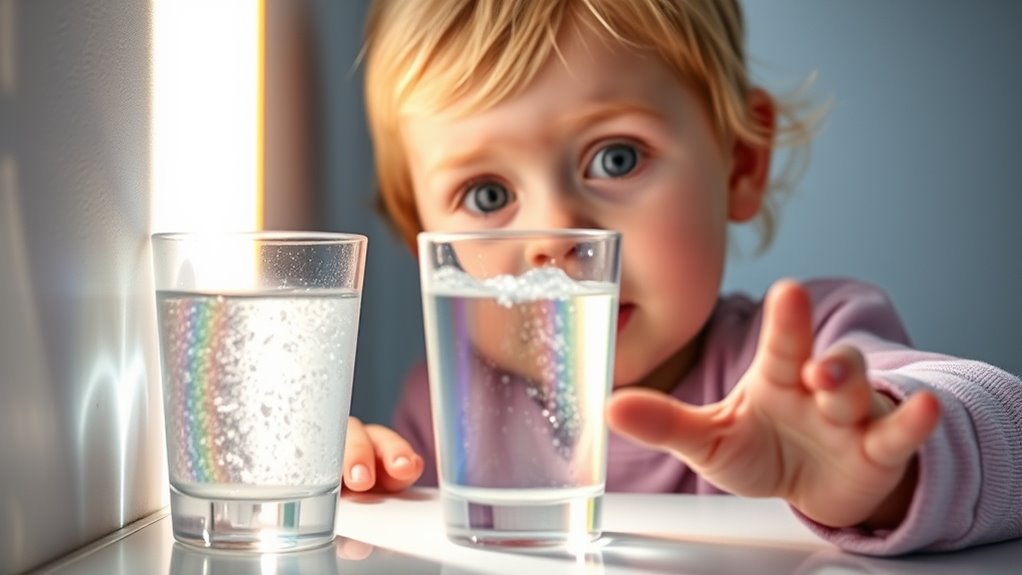
You can easily demonstrate how light creates a rainbow by using a glass of water, a mirror, and sunlight or a flashlight. Place the mirror inside the glass at an angle, so it reflects light onto a nearby surface. When sunlight or a flashlight shines through the water, the water’s transparency allows light to pass through while bending—this is called light refraction. As the light bends, it separates into different colors, creating a rainbow effect on the surface. Make sure the glass is clear and filled with water, as these guarantee the best results. This simple setup shows how light refraction occurs in water, revealing the beautiful spectrum of colors hidden within ordinary light. It’s a fun way for toddlers to see science in action. Additionally, understanding the role of light refraction helps explain why rainbows form naturally in the sky, demonstrating how optical phenomena occur in everyday life. Recognizing how scientific principles operate in simple experiments can spark curiosity and inspire further exploration. Incorporating hands-on activities like this encourages children to develop a love for science from a young age. Engaging children with such experiments can also foster a lifelong interest in science education.
Frequently Asked Questions
How Can I Ensure Safety During Toddler Science Experiments?
To guarantee safety during toddler science experiments, you should childproof the area by removing hazards like sharp objects or small items. Always supervise your child closely and use safety equipment such as goggles and gloves when necessary. Keep experiments simple and age-appropriate, and explain safety rules beforehand. Preparing the environment and monitoring closely helps prevent accidents, making the experience fun and safe for your curious toddler.
What Are Some Age-Appropriate Science Activities for Very Young Children?
Did you know that 90% of a toddler’s brain develops by age five? You can encourage their curiosity with age-appropriate science activities like sensory exploration and color mixing. Use safe, washable materials, and supervise closely. These activities boost their learning and sensory skills while keeping safety in mind. Simple experiments like mixing food coloring with water help your child explore colors and textures in a fun, safe, and educational way.
How Do I Explain Scientific Concepts to Toddlers Effectively?
When explaining scientific concepts to toddlers, you should keep it simple and engaging. Use visual aids like pictures or objects to help them see and understand. Incorporate storytelling to make ideas relatable and fun. Keep your language clear and short, encouraging questions. By combining visual aids and storytelling, you help your little one grasp basic science ideas while making learning enjoyable and memorable.
Are There Any Materials That Should Be Avoided in Toddler Experiments?
Are you wondering which materials to avoid during toddler experiments? You should steer clear of hazardous chemicals and anything that poses choking hazards. Keep small parts or sharp objects away, as they can be dangerous. Do you want to ensure a safe, fun learning environment? Always choose non-toxic, age-appropriate materials and supervise closely. By doing so, you safeguard your little explorer while nurturing their curiosity safely.
How Can I Encourage Curiosity and Questions From My Toddler During Experiments?
To encourage curiosity and questions during experiments, ask question prompts that invite your toddler to think and explore. Use curiosity sparks like “What do you think will happen?” or “Why do you think that?” to engage their mind. When they ask questions, respond with enthusiasm and simple explanations. This active participation helps foster their natural curiosity and keeps them excited about discovering new things through hands-on experiences.
Conclusion
Now you’ve navigated a world of wonder with these simple science experiments, sparking your toddler’s curiosity and creativity. From fantastic color mixing and fizzing volcanoes to static sparks and sponge surprises, each activity offers a playful peek into nature’s secrets. Keep encouraging exploration, and watch their wonder grow as they witness the magic of science. Remember, with a little patience and plenty of play, learning becomes a lively, lovely, and lifelong adventure.

